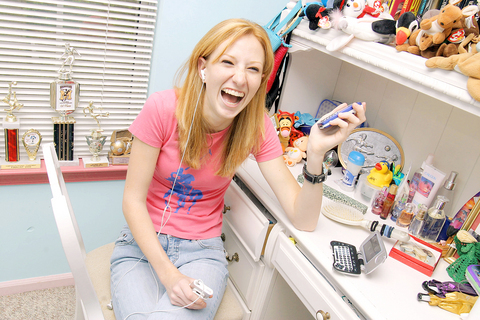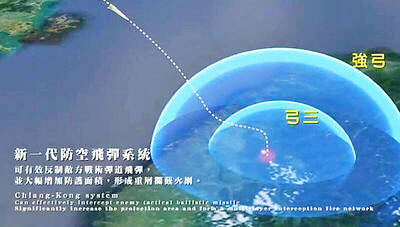Last Christmas, Kristi Stangeland, a mother of two who lives in Hastings-on-Hudson, New York, made a grievous mistake: She bought her 14-year-old daughter, Erika Hinman, a shiny new MP3 player. But it was the wrong MP3 player.
"I tried to get away with getting her an MP3 player that was US$100 cheaper," Stangeland explained sheepishly.
"I was in the biggest dog box," she said, recalling Erika's crestfallen response. "She went to school, and everyone else had got an iPod for Christmas. It was like, `How come everyone else got one, and you couldn't buy me an iPod?' So we got one for her birthday two months later."

PHOTO: NY TIMES
Although parents have long struggled with their teenagers' desire to own the newest, coolest stuff, these days the battle has reached a new dimension. While teenagers once coveted US$100 sneakers and jeans (arguably necessities because, after all, they are clothes), the must-have items now -- iPods, cell phones with cameras, and portable DVD players -- are high-tech, constantly in need of upgrade and can cost up to US$500 each. These items, which teenagers say they must have to maintain their place in the social pecking order, are increasingly out of reach for most high school students, who are less likely these days to hold part-time jobs.
Researchers who study child behavior call this pressure "nag factor" or "pester power," and often use it to describe how young children, in whom advertising has planted a desire for junk food or toys, lobby their parents. Now the same pestering is reaching a fever pitch among teenagers, who crave an ever-expanding collection of high-tech items they can't possibly afford.
The upshot is that more parents are finding themselves in the situation that Stangeland faced: footing the bill so their children can maintain social face.
"It's a good reason never to grow up," said Cary Silvers, vice president for consumer trends at Roper Youth Report, a nationwide poll from NOP World, a consumer research firm, which recently found that 18 percent of boys aged 13 to 17 surveyed owned an MP3 player, and that 37 percent owned a DVD player. But only 10 percent of the teenagers had a job, and on average they netted only US$29 a week.
"The bottom line," Silvers said, "is the majority of their purchases are subsidized by parents and other family members like grandparents."
It is a vortex of contemporary social currents: Teenagers' longing outstrips their ability to satisfy it and collides with most parents' hope to teach restraint and fiscal responsibility. The issue is not just pressing for the middle class. Teenagers of all economic groups are exposed to the same advertising and social pressures, and families rich and poor struggle with how and how much to provide.
"Parents are told by psychologists that they should pick their battles with their kids," said Susan Linn, a psychologist at Harvard Medical School and Judge Baker Children's Center.
"But should they pick the iPod battle, the cell phone battle or the R-rated movie battle? I think parents are really struggling. There are more things for kids to nag them for, and because these things are expensive, they're likely to go for their parents," she said.
It is no secret that Apple's sleek iPod, costing US$99 to US$449, has become, to the US teenager, a de rigueur fashion item, not just a handy gadget.
"The iPod blew up the category," said Sharon Lee , a founder of Look-Look Inc, a company in Hollywood that tracks teenage consumer behavior. Not only did Apple's MP3 player "open a category that just didn't exist before," she said; it changed the way teenagers thought about gadgetry.
But the iPod is not the only object of great desire.
"In the last couple of years, there seems to be a shift in badge items," said Michael Wood, a vice president at Teenage Research Unlimited in Northbrook, Illinois, which tracks youth buying patterns for more than 150 companies. "Whereas in the past it was an expensive pair of shoes or jeans -- something on the fashion side -- today the excitement and buzz is really around technology."
Tina Wells, who founded Buzz Marketing Group, another youth market researcher, based in New York, said the shift in priorities was particularly evident when she polled teenagers about what they coveted as gifts during the last holiday season. In 2003, Wells said, "it was all fashion."
"Everyone wanted a gift certificate to the Gap," she said. Last year, however, 63 percent listed a tech item as their gift of choice.
Three-quarters of teenagers between 15 and 17 now have mobile phones, up from 57 percent last year, according to the Roper Youth Report, an annual poll. Parents pay for 74 percent of the wireless plans in question, according to another survey, by the NOP World mKids Study, perhaps reflecting the fact that many parents see cell phones as a practical and safety item.
"Pretty much everybody has a cell phone, and iPods, probably one out of three people," said Greg Becker, 15, of Owings Mills, Maryland.
"It's huge. I get on my bus in the morning, everybody is listening to little white earbuds. Last year it was only a couple of kids. For guys, having an Xbox or a PS2, all the guys have those. Off the top of my head I can think of one person who doesn't," he said.
"Kids are very good, and relentless, at getting what they want, from the day they're born," said Susan Beacham, a parent of two girls, 13 and 11, in Lake Bluff, Illinois, and a founder of Money Savvy Generation, a group that coaches parents and children in fiscal responsibility.
"The pester power comes with them saying: `Mom, Madeline has one, so does Mira. Every time I want to call you, I have to borrow theirs,'" Beacham said. "It comes in the form of questioning your parenting. `Why wouldn't you keep us safe?' Then it goes to the iPod. `I've earned it, I excel in school, in excel in sports, why wouldn't you give it to me?"'
Last Christmas her 13-year-old pleaded that an iPod Mini was "a piece of the uniform," and Beacham told her she could have one as her one gift, instead of several smaller ones. But when her 11-year-old also wanted one, she was told she had to wait another year.
"For the parent, you're faced with the pressure but you do not have to do it," she said. "Your child will truly survive."

LIMITS: While China increases military pressure on Taiwan and expands its use of cognitive warfare, it is unwilling to target tech supply chains, the report said US and Taiwan military officials have warned that the Chinese People’s Liberation Army (PLA) could implement a blockade within “a matter of hours” and need only “minimal conversion time” prior to an attack on Taiwan, a report released on Tuesday by the US Senate’s China Economic and Security Review Commission said. “While there is no indication that China is planning an imminent attack, the United States and its allies and partners can no longer assume that a Taiwan contingency is a distant possibility for which they would have ample time to prepare,” it said. The commission made the comments in its annual

DETERMINATION: Beijing’s actions toward Tokyo have drawn international attention, but would likely bolster regional coordination and defense networks, the report said Japanese Prime Minister Sanae Takaichi’s administration is likely to prioritize security reforms and deterrence in the face of recent “hybrid” threats from China, the National Security Bureau (NSB) said. The bureau made the assessment in a written report to the Legislative Yuan ahead of an oral report and questions-and-answers session at the legislature’s Foreign Affairs and National Defense Committee tomorrow. The key points of Japan’s security reforms would be to reinforce security cooperation with the US, including enhancing defense deployment in the first island chain, pushing forward the integrated command and operations of the Japan Self-Defense Forces and US Forces Japan, as

INTERCEPTION: The 30km test ceiling shows that the CSIST is capable of producing missiles that could stop inbound missiles as they re-enter the atmosphere Recent missile tests by the Chungshan Institute of Science and Technology (CSIST) show that Taiwan’s missiles are capable of intercepting ballistic missiles as they re-enter the atmosphere and pose a significant deterrent to Chinese missile threats, former Hsiung Feng III missile development project chief engineer Chang Cheng (張誠) said yesterday. The military-affiliated institute has been conducting missile tests, believed to be related to Project Chiang Kung (強弓) at Pingtung County’s Jiupeng Military Base, with many tests deviating from past practices of setting restriction zones at “unlimited” and instead clearly stating a 30.48km range, Chang said. “Unlimited” restrictions zones for missile tests is

IN THE NATIONAL INTEREST: Deputy Minister of Foreign Affairs Francois Wu said the strengthening of military facilities would help to maintain security in the Taiwan Strait Japanese Minister of Defense Shinjiro Koizumi, visiting a military base close to Taiwan, said plans to deploy missiles to the post would move forward as tensions smolder between Tokyo and Beijing. “The deployment can help lower the chance of an armed attack on our country,” Koizumi told reporters on Sunday as he wrapped up his first trip to the base on the southern Japanese island of Yonaguni. “The view that it will heighten regional tensions is not accurate.” Former Japanese minister of defense Gen Nakatani in January said that Tokyo wanted to base Type 03 Chu-SAM missiles on Yonaguni, but little progress